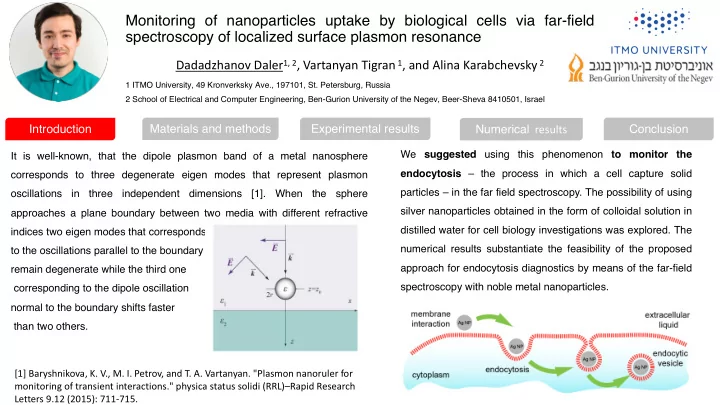

Monitoring of nanoparticles uptake by biological cells via far-field spectroscopy of localized surface plasmon resonance Dadadzhanov Daler 1, 2 , Vartanyan Tigran 1 , and Alina Karabchevsky 2 1 ITMO University, 49 Kronverksky Ave., 197101, St. Petersburg, Russia 2 School of Electrical and Computer Engineering, Ben-Gurion University of the Negev, Beer-Sheva 8410501, Israel Numerical results Materials and methods Experimental results Introduction Conclusion We suggested using this phenomenon to monitor the It is well-known, that the dipole plasmon band of a metal nanosphere endocytosis – the process in which a cell capture solid corresponds to three degenerate eigen modes that represent plasmon particles – in the far field spectroscopy. The possibility of using oscillations in three independent dimensions [1]. When the sphere silver nanoparticles obtained in the form of colloidal solution in approaches a plane boundary between two media with different refractive distilled water for cell biology investigations was explored. The indices two eigen modes that corresponds numerical results substantiate the feasibility of the proposed to the oscillations parallel to the boundary approach for endocytosis diagnostics by means of the far-field remain degenerate while the third one spectroscopy with noble metal nanoparticles. corresponding to the dipole oscillation normal to the boundary shifts faster than two others. [1] Baryshnikova, K. V., M. I. Petrov, and T. A. Vartanyan. "Plasmon nanoruler for monitoring of transient interactions." physica status solidi (RRL)–Rapid Research Letters 9.12 (2015): 711-715.
Monitoring of nanoparticles uptake by biological cells via far-field spectroscopy of localized surface plasmon resonance Dadadzhanov Daler 1, 2 , Vartanyan Tigran 1 , and Alina Karabchevsky 2 1 ITMO University, 49 Kronverksky Ave., 197101, St. Petersburg, Russia 2 School of Electrical and Computer Engineering, Ben-Gurion University of the Negev, Beer-Sheva 8410501, Israel Numerical results Materials and methods Experimental results Introduction Conclusion Fabrication of silver nanoparticles by laser ablation The scheme of numerical model( To find out the dependence of the plasmon resonance splitting contrast on the particle position for various optical properties of the adjacent media, we examined plasmon resonance excitation in a spherical nanoparticle with polarization in - x (top excitation) and -z (side excitation) direction. Herein, we assume that the biological medium has the refractive index 1.4, while the culture medium has 1.33. Nd:YAG laser at the wavelength of 532 nm
Monitoring of nanoparticles uptake by biological cells via far-field spectroscopy of localized surface plasmon resonance Dadadzhanov Daler 1, 2 , Vartanyan Tigran 1 , and Alina Karabchevsky 2 1 ITMO University, 49 Kronverksky Ave., 197101, St. Petersburg, Russia 2 School of Electrical and Computer Engineering, Ben-Gurion University of the Negev, Beer-Sheva 8410501, Israel Numerical results Materials and methods Experimental results Introduction Conclusion a b 2.4 a b To simulate the nanoparticle transition from 3 min 2.2 § = 397 nm 5 min 2.0 subcutaneous water to cellular membrane, we Optical density[arb. u.] 10 min 1.8 measured the shift of the plasmon band maximum 15 min 1.6 35 min when the nanoparticles were transferred from water 1.4 60 min 1.2 with a refractive index of 1.33 to a bovine serum 1.0 albumin solution with a refractive index of 1.4. 0.8 0.6 0.4 Ag NPs 0.5 Ag NPs with BSA 0.2 0.0 300 400 500 600 700 800 Wavelength [nm] Dl shift ~13 nm 0.4 b b 2.5 160 Optical density 80 140 Max. optical density [arb.u.] 0.3 in 2.0 Number of particles in 60 120 in FWHM [nm] in 1.5 0.2 100 40 1.0 80 0.1 20 60 0.5 0.0 0 300 350 400 450 500 550 600 40 10 20 30 40 50 60 70 80 2000 4000 6000 8000 10000 12000 Wavelength [nm] P a r t i c l e s i z e [ n m ] Number of pulse
Monitoring of nanoparticles uptake by biological cells via far-field spectroscopy of localized surface plasmon resonance Dadadzhanov Daler 1, 2 , Vartanyan Tigran 1 , and Alina Karabchevsky 2 1 ITMO University, 49 Kronverksky Ave., 197101, St. Petersburg, Russia 2 School of Electrical and Computer Engineering, Ben-Gurion University of the Negev, Beer-Sheva 8410501, Israel Numerical results Materials and methods Experimental results Introduction Conclusion 410 406 Top excitation without membrane 1.5 Top excitation with membrane Side excitation Side excitation 408 405 1.0 Splitting contrast [nm] 404 LSPR max [nm] LSPR max [nm] 406 0.5 403 NP NP 0.0 404 402 Cell Cell 401 -0.5 402 400 -1.0 400 399 -1.5 398 398 -100 -80 -60 -40 -20 0 20 40 60 80 100 -100 -80 -60 -40 -20 0 20 40 60 80 100 -100 -80 -60 -40 -20 0 20 40 60 80 10 Position along z [nm] Position along z [nm] Position along z [nm] Without cell membrane With cell membrane
Monitoring of nanoparticles uptake by biological cells via far-field spectroscopy of localized surface plasmon resonance Dadadzhanov Daler 1, 2 , Vartanyan Tigran 1 , and Alina Karabchevsky 2 1 ITMO University, 49 Kronverksky Ave., 197101, St. Petersburg, Russia 2 School of Electrical and Computer Engineering, Ben-Gurion University of the Negev, Beer-Sheva 8410501, Israel Numerical results Materials and methods Experimental results Introduction Conclusion • As a result, a colloidal solution of silver NPs in water with diameters of 20 to 50 nm, free from stabilizing agents, was obtained • The possibility of using silver NPs obtained by laser ablation in water for monitoring the process of endocytosis was confirmed • The theoretical results of the endocytosis model for single nanoparticle penetrated through a thin cell membrane has been numerically developed • When the spherical nanoparticle approaches a cell, its triple degenerate dipole plasmon resonance splits into two components: a non-degenerate mode, corresponding to oscillation along the line connecting the particle to the cell, and a doubly degenerate mode, corresponding to oscillation in perpendicular directions. Contact facebook: https://www.facebook.com/principfree Email: daler.dadadzhanov@gmail.com
Recommend
More recommend